Punjab State Board PSEB 11th Class Chemistry Book Solutions Chapter 13 Hydrocarbons Textbook Exercise Questions and Answers.
PSEB Solutions for Class 11 Chemistry Chapter 13 Hydrocarbons
PSEB 11th Class Chemistry Guide Hydrocarbons InText Questions and Answers
Question 1.
How do you account for the formation of ethane during the chlorination of methane?
Answer:
Chlorination of methane proceeds via a free radical chain mechanism. The whole reaction takes place in the given three steps :
Step 1: Initiation : The reaction begins with the homolytic cleavage of Cl—Cl bond as:

Step 2: Propagation : In the second step, chlorine free radicals attack methane molecules and break down the C—H bond to generate methyl radicals as:

These methyl radicals react with other chlorine free radicals to form methyl chloride along with the liberation of a chlorine free radical.

Hence, methyl free radicals and chlorine free radicals set up a chain reaction. While HC1 and CH3C1 are the major products formed, other higher
halogenated compounds are also formed as:

Step 3: Termination : Formation of ethane is a result of the termination
of chain reactions taking place as a result of the consumption of reactants as:

Hence, by this process, ethane is obtained as a by-product of chlorination of methane.
![]()
Question 2.
Write IUPAC names of the following compounds : ,
(a) CH3CH = C(CH3)2
(b) CH2 = CH — C = C — CH3
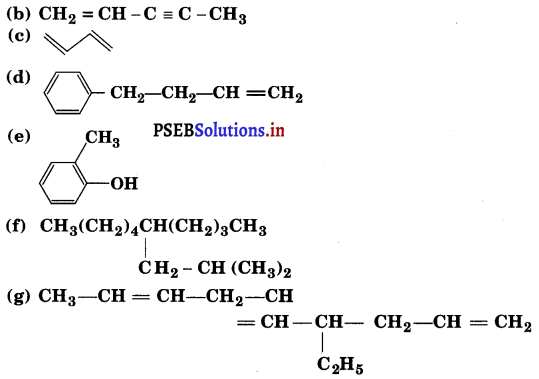
Answer:
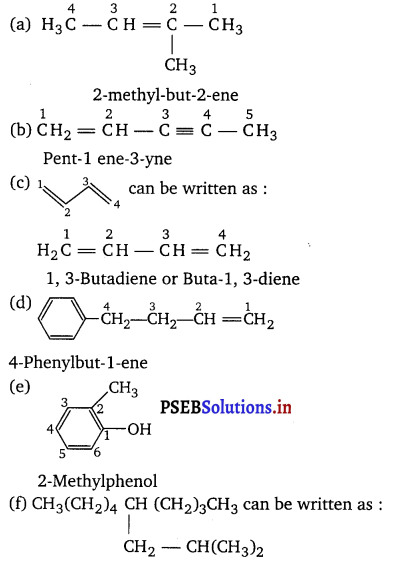
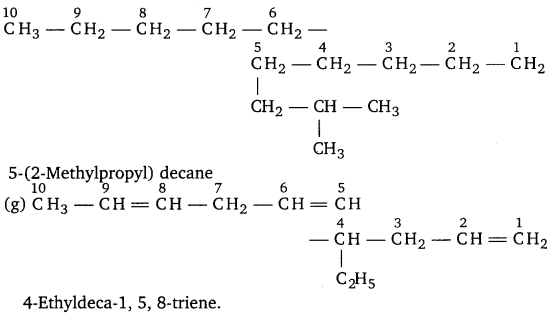
Question 3.
For the following compounds, write structural formulas and IUPAC names for all possible isomers having the number of double or triple bond as indicated:
(a) C4H8 (one double bond)
(b) C5H8 (one triple bond)
Answer:
(a) The following structural isomers are possible for C4H8 with one double bond:
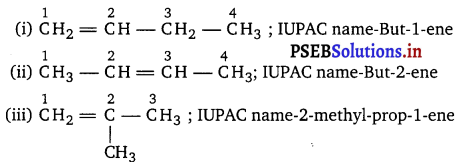
(b) The following structural isomers are possible for C5H8 with one triple bond:

Question 4.
Write IUPAC names of the products obtained by the ozonolysis of the following compounds:
(i) Pent-2-ene
(ii) 3,4-Dimethylhept-3-ene
(iii) 2-Ethylbut-l-ene
(iv) 1-Phenylbut-l-ene
Answer:
(i) Pent-2-ene undergoes ozonolysis as:
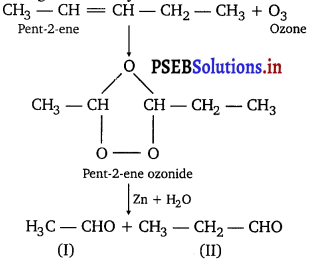
The IUPAC name of product (I) is ethanal and product (II) is propanal.
(ii) 3, 4-Dimethylhept-3-ene undergoes ozonolysis as:
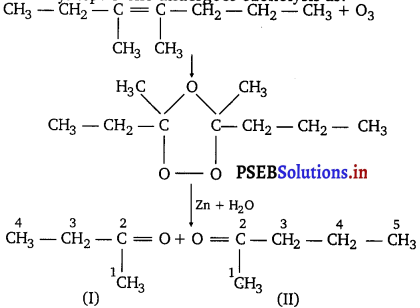
The IUPAC name of product (I) is butan-2-one and product (II) is pentan-2-one.
(iii) 2-Ethylbut-l-ene undergoes ozonolysis as:
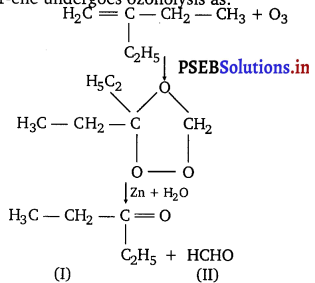
The IUPAC name of product (I) is pentan-3-one and product (II) is methanal.
(iv) 1-Phenylbut-l-ene undergoes ozonolysis as:
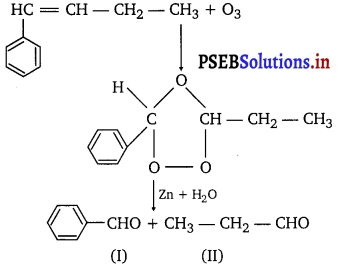
The IUPAC name of product (I) is benzaldehyde and product (II) is propanal.
![]()
Question 5.
An alkene ‘A’ on ozonolysis gives a mixture of ethanal and pentan-3-one. Write structure and IUPAC name of ‘A’.
Answer:
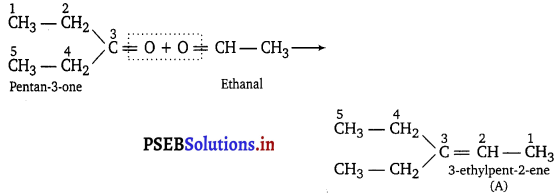
Question 6.
An alkene ‘A’ contains three C — C, eight C — Hσ bonds and one C — C π bond. ‘A’ on ozonolysis gives two moles of an aldehyde of molar mass 44 u. Write IUPAC name of ‘A’
Answer:
As per the given information, ‘A’ on ozonolysis gives two moles of an aldehyde of molar mass 44 u. The formation of two moles of an
aldehyde indicates the esence of identical structural units on both sides of the double bond containing carbon atoms.
Hence, the structure of ‘A’ can be represented as :
XC = CX
There are eight C—Ha bonds. Hence, there are 8 hydrogen atoms in ‘A’. Also, there are three C—C bonds. Hence, there are four carbon atoms present in the structure of‘A’.

Combining the inferences, the structure of A’ can be represented as:
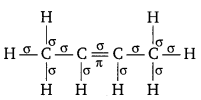
‘A’ has 3 C — C bonds, 8 C — H bonds, and one C— C it bond. Hence, the IUPAC name of ‘A’ is But-‘ 2-ene.
Ozonolysis of ‘A’ takes place as:
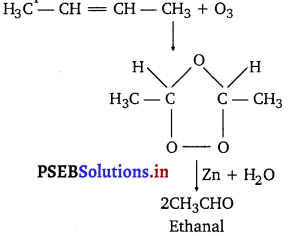
The final product is ethanal with molecular mass
= [(2 x 12) + (4 x 1) + (1 x 16)]= 44 u
Question 7.
Propanal and pentan-3-one are the ozonolysis products of an alkene? What is the structural formula of the alkene?
Answer:

Question 8.
Write chemical equations for combustion reaction of the following hydrocarbons:
(i) Butane
(ii) Pentene
(iii) Hexyne
(iv) Toluene
Answer:
Combustion can be defined as a reaction of a compound with oxygen.
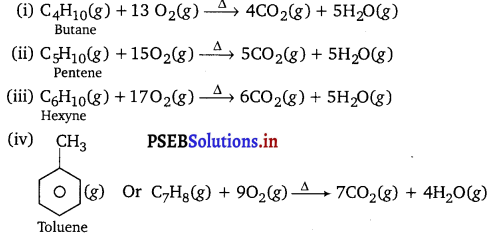
Question 9.
Draw the cis and trans structures of hex-2-ene. Which isomer will have higher b.p. and why?
Answer:
Hex-2-ene is represented as:
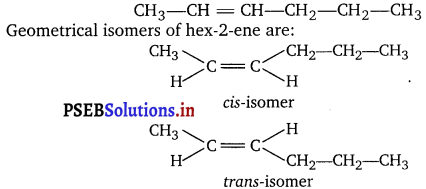
The cis-isomer will have higher boiling point due to more polar nature leading to stronger intermolecular dipole-dipole interactions thus requiring more heat energy to separate them, whereas trans form being non-polar have weak induced dipole interactions and so have lower boiling point.
![]()
Question 10.
Why is benzene extra ordinarily stable though it contains three double bonds?
Answer:
Resonance and delocalization of electrons generally leads to the stability of benzene molecule.

The dotted circle in the hybrid structure represents the six electrons which are delocalised between the six carbon atoms of the benzene ring. Therefore, presence of delocalised Jt electrons in benzene makes it more stable than the hypothetical cyclohexatriene.
Question 11.
What are the necessary conditions for any system to be aromatic?
Answer:
A compound is said to be aromatic if it satisfies the following three conditions:
(i) It should have a planar structure.
(ii) The π-electrons of the compound are completely delocalized in the ring.
(iii) The total number of π-electrons present in the ring should be equal to (4n + 2), where n = 0,1, 2….etc. This is known as Huckel’s rule.
Question 12.
Explain why the following systems are not aromatic?

Answer:

For the given compound, the number of π-electrons is six. But only four Tt-electrons are present within the ring. Also there is no conjugation of π-electrons within the ring and the compound is not planar in shape. Hence, the given compound is not aromatic in nature.

For the given compound, the number of π-electrons is four.
By Huckel’s rule,
4n + 2 = 4,
4n = 2, n = 1/2
For a compound to be aromatic, the value of n must be an integer (n = 0,1,2 …), which is not true for the given compound. Hence, it is not aromatic in nature.

For the given compound, the number of it-electrons is eight.
By Huckel’s rule.
4n + 2 = 8
4n = 6, n = 3/2
For a compound to be aromatic, the value of n must be an integer (n = 0,1, 2…). Since, the value of n is not an integer, the given compound is not aromatic in nature.
Question 13.
How will you convert benzene into
(i) p-nitrobromobenzene
(ii) m-nitrochlorobenzene
(iii) acetophenone
(iv) p-nitrotoluene
Answer:
(i) Benzene can be converted into p-nitrobromobenzene as:
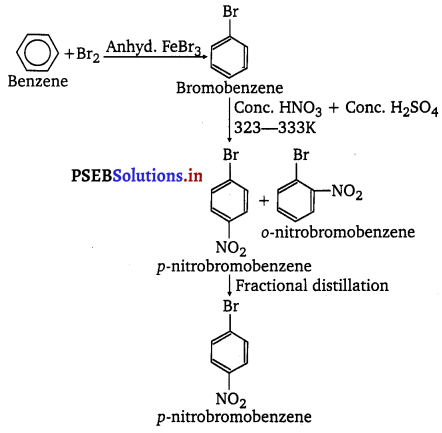
(ii) Benzene can be converted into m-nitrochlorobenzene as:
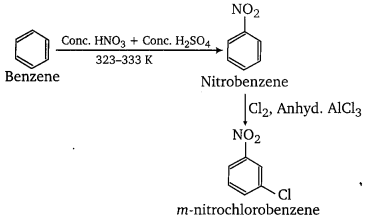
(iii) Benzene can be converted into acetophenone as:

(iv) Benzene can be converted into p-nitrotoluene as:
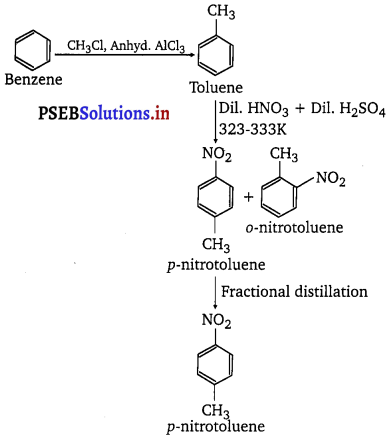
![]()
Question 14.
In the alkane H3C — CH2 — C(CH3)2 — CH2 — CH(CH3)2 identify 1°, 2°, 3° carbon atoms and give the number of H atoms bonded to each one of these.
Answer:
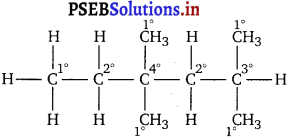
1° carbon atoms are those which are bonded to only one carbon atom, i.e., they have only one carbon atom as their neighbour. The given structure has five 1° carbon atoms and fifteen hydrogen atoms are attached to it.
2° carbon atoms are those which are bonded to two carbon atoms, i.e., they have two carbon atoms as their neighbours. The given structure has two 2° carbon atoms and four hydrogen atoms are attached to it.
3° carbon atoms are those which are bonded to three carbon atoms, i.e., they have three carbon atoms as their neighbours. The given structure has one 3° carbon atom and only one hydrogen atom is attached to it.
Question 15.
What effect does branching of an alkane chain has on its boiling point?
Answer:
Alkanes experience inter-molecular Van der Waals forces. The stronger the force, the greater will be the boiling point of the alkane.
As branching increases, the surface area of the molecule decreases which results in a small area of contact. As a result, the Van der Waals force also decreases which can be overcome at a relatively lower temperature. Hence, the boiling point of an alkane chain decreases with an increase in branching.
Question 16.
Addition of HBr to propene yields 2-bromopropane, while in the presence of benzoyl peroxide, the same .reaction yields
1- bromopropane. Explain and give mechanism.
Answer:
Addition of HBr to propene is an example of an electrophilic substitution reaction.
Hydrogen bromide provides an electrophile, H+. This electrophile attacks the double bond to form 1° and 2° carbocations as shown:
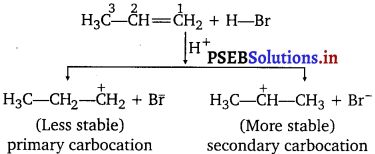
Secondary carbocations are more stable than primary carbocations. Hence, the former predominates since it will form at a faster rate. Thus, in the next step, Br– attacks the carbocation to form 2 – bromopropane as the major product.

This reaction follows Markovnikov’s rule where the negative part of the addendum is attached to the carbon atom having a lesser number of hydrogen atoms.
In the presence of benzoyl peroxide an addition reaction takes place against Markovnikov’s rule. The reaction follows a free radical chain mechanism as:
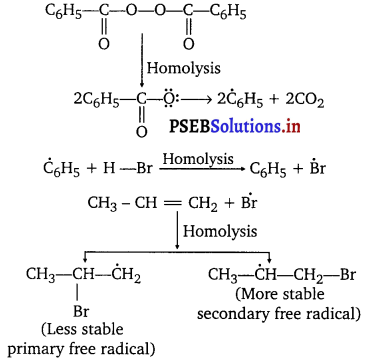
Secondary free radicals are more stable than primary radicals. Hence, the former predominates since it forms at a faster rate. Thus, 1-bromopropane is obtained as the major product.

In the presence of peroxide, Br free radical acts as an electrophile. Hence, two different products are obtained on addition of HBr to propene in the absence and presence of peroxide.
Question 17.
Why does benzene undergo electrophilic substitution reactions easily and nucleophilic substitutions with difficulty?
Answer:
Benzene is a planar molecule having delocalized electrons above and below the plane of ring. Hence, it is electron-rich. As a result, it is highly attractive to electron deficient species i.e., electrophiles. Therefore, it undergoes electrophilic substitution reactions very easily. Nucleophiles are electron-rich. Hence, they are repelled by benzene. Hence, benzene undergoes nucleophilic substitutions with difficulty.
Question 18.
Write down the products of ozonolysis of 1, 2-dimethylbenzene (o-xylene). How does the result support Kekule structure for benzene?
Answer:
o-xylene has two resonance structures:
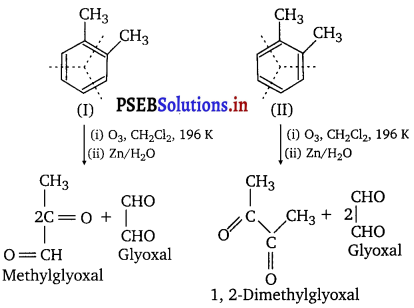
All three products, i.e., methyl glyoxal, 1, 2-dimethyl glyoxal, and glyoxal are obtained from two Kekule structures. Since all three products cannot be obtained from any one of the two structures, this proves that o-xylene is a resonance hybrid of two Kekule structures (I and II).
Question 18.
Arrange benzene, n-hexane and ethyne in decreasing order of acidic behaviour. Also give reason for this behaviour.
Answer:
Acidic character of a species is defined on the basis of ease with which it can lose its H-atoms.
The hybridization state of carbon in the given compound is:

As the s-character increases, the electronegativity of carbon increases and the electrons of C—H bond pair lie closer to the carbon atom. As a result, partial positive charge of H-atom increases and H+ ions are set free.
The s-character increases in the order:
sp3 < sp2 < sp Hence, the decreasing order of acidic behaviour is Ethyne > Benzene > Hexane.
![]()
Question 20.
How would you convert the following compounds into benzene?
(i) Ethyne (ii) Ethene (iii) Hexane
Answer:
(i) Benzene from Ethyne:

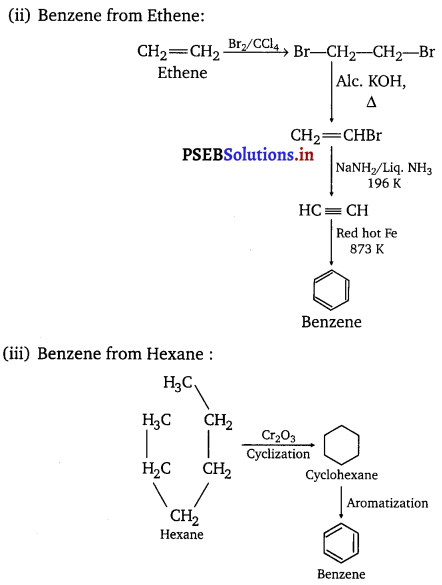
Question 21.
Write structures of all the alkenes which on hydrogenation give 2-methyl butane.
Answer:
The basic skeleton of 2-methyl butane is

Putting double bonds at various different positions and satisfying the tetracovalency of each carbon, the structures of various alkenes which give 2-methyl butane on hydrogenation are:

Question 22.
Arrange the following set of compounds in order of their decreasing relative reactivity with an electrophile, E+
(a) Chlorobenzene, 2, 4-dinitrochlorobenzene, p-nitrochlorobenzene
(b) Toluene, p-H3C—C6H4—NO2, p-O2N — C6H4 — NO2
Answer:
Electrophiles are reagents that participate in a reaction by accepting an electron pair in order to bond to nucleophiles.
The higher the electron density on a benzene ring, the more reactive is the compound towards an electrophile, E+ (Electrophilic reaction).
(a) The presence of an electron withdrawing group (i.e., —NO2 and Cl) deactivates the aromatic ring by decreasing the electron density. Since, —NO2 group is more electron withdrawing (due to resonance effect) than the —Cl group (due to inductive effect) the decreasing order of reactivity is as follows :
Chlorobenzene > p-nitrochlorobenzene > 2, 4-dinitrochlorobenzene
(b) While —CH3 is an electron donating group, —NO3 group is electron withdrawing. Hence, toluene will have the maximum electron density and is most easily attacked by E+.
—NO2 is an electron withdrawing group. Hence, when the number of —NO2 substituents is greater, the order is as follows:
Toluene > p-CH3—C6H4—NO2 > p-ON2—C6H4—NO2
Question 23.
Out of benzene, m-dinitrobenzene and toluene which will undergo nitration most easily and why?
Answer:
The ease of nitration depends on the presence of electron density on the compound to form nitrates. Nitration reactions are examples of electrophilic substitution reactions where an electron-rich species is attacked by a nitronium ion (\(\mathrm{NO}_{2}^{-}\)).
Now, —CH3 group is electron donating and —NO2 is electron withdrawing. Therefore, toluene will have the maximum electron density among the three compounds followed by benzene. On the other hand, m-Dinitrobenzene will have the least electron density. Hence, it will undergo nitration with difficulty. Hence, the increasing order of nitration is as follows:
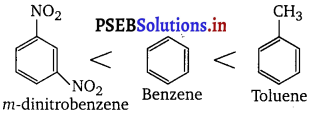
Question 24.
Suggest the name of a Lewis acid other than anhydrous aluminium chloride which can be used during ethylation of benzene.
Answer:
The ethylation reaction of benzene involves the addition of an ethyl group on the benzene ring. Such a reaction is called a Friedel-Crafts alkylation reaction. This reaction takes place in the presence of a Lewis acid.
Any Lewis acid like anhydrous FeCl3, SnCl4, BF3 etc. can be used during the ethylation of benzene.
![]()
Question 25.
Why is Wurtz reaction not preferred for the preparation of alkanes containing odd number of carbon atoms? Illustrate your answer by taking one example.
Answer:
Wurtz reaction is limited for the synthesis of symmetrical alkanes (alkanes with an even number of carbon atoms) in the reaction, two
similar alkyl halides are taken as reactants and an alkane, containing double the number of carbon atoms, are formed. Example:
![]()
Wurtz reaction cannot be used for the preparation of unsymmetrical alkanes because if two dissimilar alkyl halides are taken as the reactants, then a mixture of alkanes is obtained as the products. Since the reaction involves free radical species, a side reaction also occurs to produce an alkene. For example, the reaction of bromomethane and iodoethane gives a mixture of alkanes.

The boiling point of alkanes (obtained in the mixture) are very close. Hence, it becomes difficult to separate them.